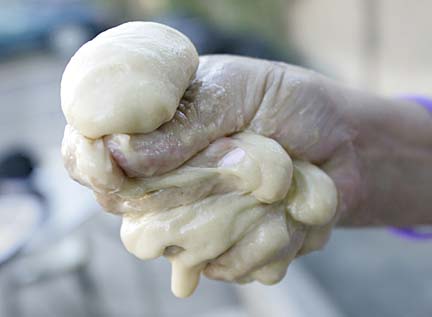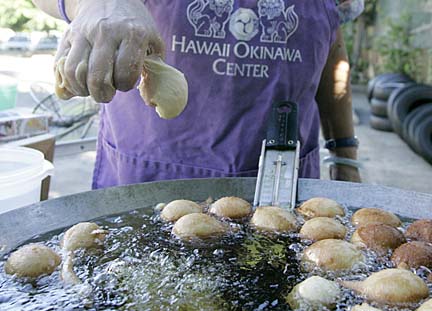
|

Everyone has a special way
to make the tasty dough balls
|
Whatever. It's no secret that during the Okinawan Festival this weekend, tens of thousands of andagi will be fried up and consumed. Thousands of brown spheres the size of cue balls bobbing in hot oil, thousands of paper bags turning translucent with oil secretions and smelling like a bakery in full swing. There are people who look forward to this all year.
I asked to see for myself how andagi is made, and Ellen Higa, mother Jane Sakima and aunt Betsy Miyahira fired up a wok to demonstrate. Uncle Robert Miyahira was there, too, but he mostly swooped in and out to sample the samples. Somebody's gotta do it.
"My family won't eat cold andagi," said Higa, watching Uncle Robert. "It's best when it's fresh, still warm. Don't let it sit. That's the secret."

|
THAT'S the secret?
"Actually," said Miyahira, "The secret is the way it's mixed. Fold it gently, don't whip it. Otherwise it cooks hard."
"Fold it in, fold it in," said Higa, demonstrating with the pale golden batter made of flour, sugar, baking powder, evaporated cream, eggs and vanilla. "When men mix it up, they put a lot of strength into it, and beat it up, but that takes the fluffiness out. Better to be gentle."
The ideal batter texture is rather like Play-Doh. Or drywall compound. Or cake frosting. Once it's mixed, you grab a handful, squeeze it in your palm and extrude a bulb about the size of a golf ball out of the lip-like crack between thumb and forefinger.
"Better have clean hands. And wet is good," said Miyahira. I don't know if that was an andagi secret or a lifestyle suggestion.
The bulb drops into the oil and cooks in about eight minutes, puffing up and turning golden-brown. That's why the technique is called "dropping."
Batter that's too liquid can be used for dipping hot dogs to make andadogs, the Okinawan equivalent of corndogs.
 |
How critical is the temperature?
"Very," said Miyahira. "About 330 degrees, that's the secret. Too hot, and the outside cooks too dark and the inside stays too doughy, too raw. Too low, and the oil soaks in too much. Use clean oil! Change it every day."
There's mythology about the little "tail" created when the dough is squeezed out of the hand. Dribble it out, and you wind up with something that looks like deep-fried pollywogs. Do it with the right snap and ...
"It looks like a smile," said Higa.
"Or it opens up like a flower," said Miyahira. "The tail gotta be crunchy to eat."
"Every andagi is different, because everyone's hands are different," said Higa. "I've seen people with really big hands scoop up the batter and squeeze out a dozen drops."
The difference between andagi and donut holes is that donuts use yeast, creating something that's mostly puffed air. Andagi are solid, baby. You test them like a baked good, however, by poking with a wooden skewer. If the skewer comes out clean, it's done.

|
"It will keep for a couple of days," said Higa. "Some people freeze them and reheat in a toaster oven."
"President Clinton came to the festival and stopped by the andagi booths," said Uncle Robert. "He ate plenty, came back, ate plenty more. Next day, Secret Service came and scooped up even plenty more."
"A lot of Okinawan foods are influenced by both Japanese and Chinese," said Higa. "Of course, we have Portuguese friends who claim they invented andagi, like a round malasada."
What's not in dispute is the baked ball's popularity. Andagi frying doesn't reach back into the mists of Hawaii plantation history. It underwent a spurt of popularity in the 1970s at the Hawaii State Farm Fair, held then at McKinley High School -- and never let go.
Now more than 100,000 are sold at the Okinawan Festival. They cook hundreds at a time in huge vats, and folks line up in patient droves.
But the average person can whip up andagi at home. It was, after all, designed as the poor man's box-lunch treat.
I gave it a try, thanks to these patient ladies and their rather simple fryer made of a propane jet, metal drum and a wok, and what do you know? Edible, properly shaped andagi were created right off the bat.
And here's another secret -- licking the batter off your fingers is pretty tasty too. Just wait until you're done making andagi for others.
by his editor, who has a very long memory, and who recalls that
Burlingame once choked on stale week-old andagi and proclaimed
them "Okinawan death balls." He has since been shown the
error of his opinion.

|
Make it yourself
This recipe for andagi comes from "Okinawan Mixed Plate," published by Hui O Laulima, the women's auxiliary of the United Okinawan Association of Hawaii.Note that it calls for an oil temperature of 350 degrees, standard for deep-frying. Our andagi expert, Betsy Miyahira, however, suggests a lower temperature -- 330 degrees.
Hawaii Style Andagi
4 cups flour
4 teaspoons baking powder
2 cups sugar
1/2 teaspoon salt
1/3 cup evaporated milk
2 tablespoons vegetable oil
1 teaspoon vanilla
4 large eggs, slightly beaten
Vegetable oil, for deep frying
Combine flour, baking powder, sugar and salt. Make a well in center.
Combine milk, oil and vanilla in a measuring cup, then add enough water to make 1 cup of liquid. Add eggs. Pour into well in dry ingredients. Mix by hand until barely moist. Preheat oil to 350 degrees. (See note above.)
Drop dough by hand, or use a large spoon or ice cream scoop. Fry until golden, about 8 minutes. Andagi is done when a skewer poked into the center comes out clean. Drain on paper towels.
Nutritional information unavailable.

|
|
E-mail to Features Desk
[News] [Business] [Features] [Sports] [Editorial] [Do It Electric!]
[Classified Ads] [Search] [Subscribe] [Info] [Letter to Editor]
[Feedback]
